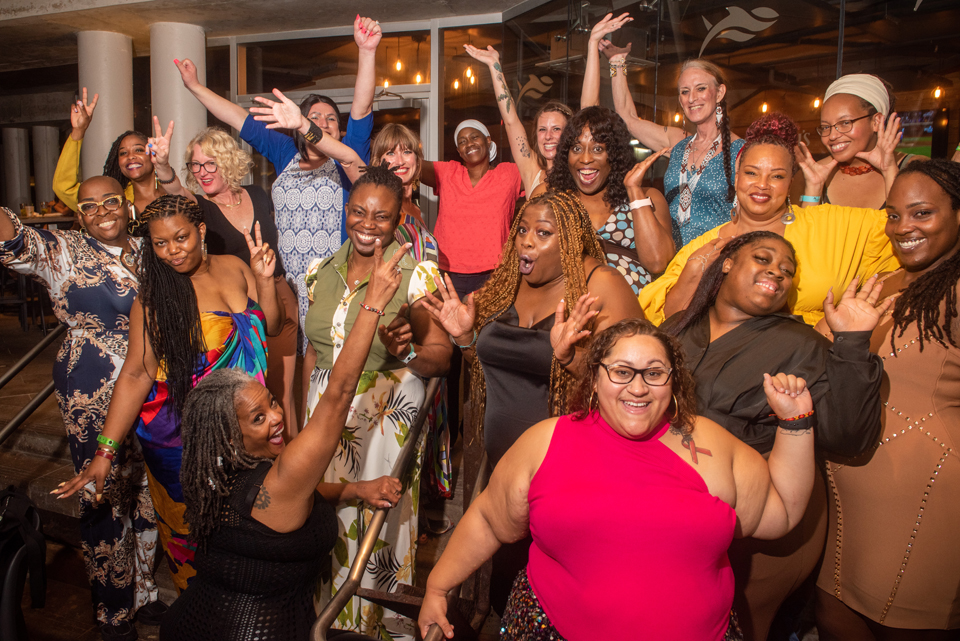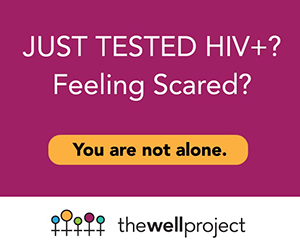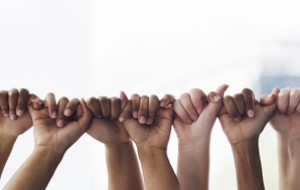By Bridgette Picou and Katie Willingham
Members of The Well Project's Community Advisory Board attended, presented, and reported their perspectives on the virtual US Conference on HIV/AIDS (USCHA), December 2 - 3, 2021. We've compiled their takeaways from the gathering into several multi-author topical articles. Read on for summaries of presentations related to the state of the US HIV epidemic – and check out all The Well Project’s coverage of the US's largest HIV community convening.
Table of Contents
- Facts and Reflections on HIV in the US Today
- Complicated Roles of Church and Faith for Women Living with HIV
- View from the US South
Facts and Reflections on HIV in the US Today
Katie Willingham
"We can only end the epidemic if we're all at the table," I heard Dr. Rachel Levine (I mean, newly appointed Admiral Rachel Levine, MD) say on the first day of USCHA 2021. What a kick off it was! To start the conversation we heard from Dr. Levine – assistant secretary for health of the US Department of Health and Human Services and the highest ranked woman of transgender experience in the United States. She talked about meaningful community engagement, equality and inclusion, and the meaningful involvement of people living with HIV.
We heard from a host of amazing advocates, including Ronald Johnson of the US PLHIV Caucus; Naina Khanna of Positive Women's Network – USA; Cecilia Chung of Transgender Law Center; and Mark Misrok of the National Working Positive Coalition, all of whom were fantastic speakers.
Then Anthony Fauci, MD – top infectious disease doctor in the US, chief medical advisor to US President Joe Biden, and director of the National Institute of Allergy and Infectious Diseases – gave an update on HIV in the US over the past 40 years:
- There are 1.2 million people living with HIV and 13 percent of them do not know it
- There were 35,000 people newly diagnosed with HIV in 2019 – 14 percent were between 13-24 years old and 30 percent were between 25-34 years old
- By the end of that same year, a total of 766,000 people with AIDS had died since the beginning of the epidemic
There have been tremendous advances in many aspects of HIV science from 1981 to the present. Yet one of the most important biomedical research advances of our era is still highly effective antiretroviral therapy for HIV, which makes possible U=U (Undetectable Equals Untransmittable) – the scientific fact that proper adherence to effective treatment can lead to an undetectable viral load (meaning that there is not enough virus to be counted in blood tests), which makes it impossible to transmit HIV during sex. And since 1981, scores of effective antiretroviral drugs have been approved by the FDA (US Food and Drug Administration), including 13 single-tablet, once-a-day antiretroviral regimens approved in the US.
There remain implementation gaps that must be addressed in testing, treatment, retention in care, viral suppression, prevention and harm reduction services, food and housing insecurity, and human rights – including stigma and discrimination reduction. These gaps must be addressed because globally there were 37.7 million people living with HIV in 2020 yet only 27.5 million people were on antiretroviral therapy; that's a treatment gap of over 10.2 million people. Too-low retention in HIV treatment means that we need to find ways to control the virus that don't require daily HIV drugs. Promising strides are being made on this front, including investigations into:
- long-acting antiretroviral treatments (the first of which, Cabenuva (cabotegravir; rilpivirine), was approved by the FDA to treat HIV in January 2021);
- broadly neutralizing antibodies (bNAbs); and even eventually
- completely ridding bodies of HIV (eradication).
Some potential strategies to eradicate HIV range from latency-reversing agents to deplete HIV reservoirs, modified antibodies and/or effector cells directed at reservoirs, stem cell transplantation, and gene editing. Researchers have launched a trial of mRNA vaccines for HIV; the experimental vaccines use the same technology as the highly effective Moderna and Pfizer COVID-19 vaccines. As the journey toward an HIV vaccine continues, Dr. Fauci said: "We must steadily and steadfastly move forward to address critical research gaps and unanswered questions."
It was a fascinating presentation by Dr. Fauci. After his presentation there were several revered current and former US representatives – including Barney Frank and Barbara Lee, who introduced Speaker of the House Nancy Pelosi, who was being awarded the NMAC Lifetime Achievement Award for her lifelong involvement in the fight against HIV/AIDS.
Finally the plenary session was closed out with a performance by the one and not-so-only Beyoncé!! At first I was astounded and ecstatic that Beyoncé came to USCHA -- until I realized that she was just a very talented impersonator. But she gave a Beyoncé-worthy performance!
Complicated Roles of Church and Faith for Women Living with HIV
Bridgette Picou
I was drawn to the session "SHERO - The Impact of Faith in Conversations with Women Living with HIV" for a couple of reasons – mostly selfish, I'm unashamed to admit. I had been telling a coworker that I needed to get back to church. I have always had a complicated relationship with God and the church. As a child I remember being jealous when my cousin made First Communion. Not only because she looked so pretty in her dress, but because she "knew" more about God than me and she was younger. I also remember my aunt losing a little of her faith when my cousin, who was her daughter, passed away, and she had always been a staunch Catholic.
I wouldn't say I struggle with faith per se; it's more being cautious around it and the people who shout about it. I have had some real breakthroughs in church, but I have also heard a whispered conversation (or three) about me. The Black Church has always been a cornerstone of the Black community. For me, having grown up in Catholic church, having been exposed to Baptist church, and as an adult leaning more into a non-denominational way of thinking, I've always had one hand up to praise God and a side-eye on the congregation. Sometimes, as much as the church is a refuge, it is also a place of stigma and judgment.
Nonetheless, the session was a good one. It was well rounded in that it was presented by a person with HIV lived experience, a researcher, and a faith leader – all Black women in HIV/AIDS work. Done as more of a conversation than a presentation, there were quite a few topics discussed in a short time. It covered everything from the basics of where and how Black women are (under)represented in media and research, to when and how the burden of HIV is discussed – most pointedly, that we aren't seen and heard from enough in these spaces. Facts and figures point out that the most vulnerable populations are young gay Black and Latinx men, followed closely by Black women. Yet media, literature, and research heavily exclude us, promoting inequity in part by placing the burden of making Black women heard and visible on us alone.
The role of women has evolved within the church over the years. Women have gone from being space warmers in the pew to vital, active caretakers in the church. They have gained the ability to preach, pastor, and lead. There were several other points made that stuck out to me as it relates to women in HIV (I'm paraphrasing in the following):
- Efforts toward increasing representation don't always translate into real-world results
- We are still at the whim of providers and their biases and prejudices
- Medications are not enough – we need the wraparound services that address things like mental health care, housing, substance abuse issues, child care and food insecurities
- Trauma-informed/centered care – traumas are not just the things that we consider the traditional ones, i.e., getting an HIV diagnosis, or rape and molestation. The reality is just being a Black woman in America is traumatic. Showing up in spaces every day where you are seen first and only as Black and female and angry or ghetto or any of the other things that get ascribed to us is exhausting.
- Religion vs a relationship with God – being able to quote scripture is religion; believing in the scripture is relationship
All of these factors (and more) are where faith and a relationship with God come into play. Black women have always had what is perceived to be unyielding strength, but it's imperative we remember that we are resilient but not indestructible. A lot of that comes from the Church. Faith is multifaceted. Even within Black culture there are different belief paths under the umbrella of conviction. For those not familiar with conviction as it relates to religion, it is the assertion that a person and their actions are directed by God. The belief that no matter what, if you remain faithful and patient the Lord will guide you through. This is the Church Path, or at least one of them. Traditionally the Church is the foundation to keep going, the liberator. It's where we find peace in the storm. The place we arm ourselves for daily battles with scripture and fellowship and collective belief, with shared stories.
It is not a perfect space, though. There are dangers in blind faith. Extremes like faith as medicine or not taking medication because the Lord will "heal infirmities." The Church is not free from stigma and that judgment I mentioned earlier. A church body is not always nurturing outside of what it thinks of as traditional values. Most of the ways HIV is acquired are not included in those values. Sometimes the Church is so busy with fire and brimstone on some of the behaviors and risk factors that make people vulnerable to the disease, that it forgets that HIV is a human and a health condition.
One of the ladies asked a pertinent question: What is the agreement between the government and Church of use of the word Faith? I would take it a little bit further to say: What is the agreement between the Church and the Church Body (the congregation) about the use of the word Faith? Shouldn't my unwavering faith grant me acceptance and freedom from stigma within the Church?
At the end of day, I believe the Church and church spaces are one of the places more resources and training need to go into. The Church could not only be a cornerstone for faith; it could be a beacon for helping reduce stigma and providing a safe haven for those battling HIV. While youth and health ministries have made strides into education, there is still work to be done when it comes to acceptance and battling stigma among the church elders. I can say, to be honest and rounded, that my perseverance in life as a woman living with HIV is due in part to lessons learned from sitting in a pew on Sundays. Even though I may side eye the congregation, I still have hope. And Faith.
View from the US South
Katie Willingham
Of all new HIV diagnoses in the US, over half are from the southeastern portion of the country. We also have lower rates of adherence and retention to care.
"This is Our Story: HIV Impact and Opportunities in the Rural South" was presented by the Southern AIDS Coalition, and I was honored to be a member of the panel. We spoke about the challenges and barriers embedded into the Southern culture that obstruct meaningful advancements in efforts to control and end the HIV epidemic in the South.
All the panelists gave their opinions as to what they considered to be the greatest barriers to their advocacy efforts and what is needed to overcome them. I spoke about religion being a major obstacle and source of stigma in the rural South, but gave hope that things in the South are gradually changing. I spoke about the importance to me to live openly with my status, sharing my story, and being a public face of HIV in order to humanize this condition for all people.
Other panelists talked about cooperation and collaboration among advocates and allies, the lack of real sex education in public schools, inequities imbedded into the culture, lack of resources, and engaging in uncomfortable conversations with conservatives about sex and more.
The South has yet a long way to go toward ending the epidemic, and getting the rest of the way will not be easy or comfortable, but gradually we're getting there. This is no time to give up due to the difficulty of the task. As Rachel Maddow once said: "The weight of it doesn't mean we can walk away from it."





